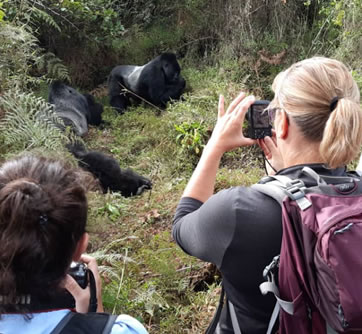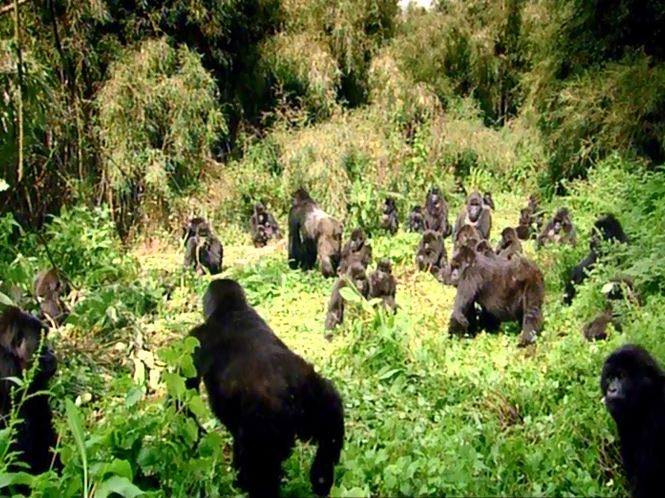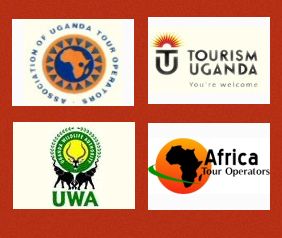Mountain Gorilla Conservation Tourism in Uganda
Mountain Gorilla Conservation History
Mountain Gorillas were considered worthy protection and the American Carl Akeley persuaded the Belgians to protect their Congolese and Rwandan Volcano slopes in the new Parc National des Albert, Africa’s first national park in 1925. The Uganda slopes were declared a gorilla game sanctuary in 1931 but it was still not until 1960 that anyone bothered to observe gorillas sufficiently to appreciate their true nature.
The Mountain Gorilla Conservation Fund (MGCF) is devoted to the preservation and protection of the highly endangered Mountain Gorillas in Africa, their habitat, and working with the people around the National Parks. The Denver Gorilla Run is a charity fun run with a difference. Everyone who takes part wears a full gorilla costume – from feathery head to hairy toe and helps raise funds for the Mountain Gorilla Conservation Fund, the international charity working to save the world’s last remaining mountain gorillas and keeping Dian Fossey’s dream alive for the past 30 years.
The World Bank and the UN have recognized the initiative of the Uganda Wildlife Authority (UWA) in the protection of the globally endangered mountain gorillas in Uganda. Uganda is the only country in which gorilla populations have been time after time on the rise and where the population is part of effective matter. Legislation that recognizes its habitats within a gazetted national system of protected areas. An excellent way to help protect the last remaining mountain gorillas is to adopt a gorilla. The Dian Fossey Gorilla Fund International (DFGFI) makes this possible with profits from adoptions directly going to support research on the mountain gorillas and the local communities living in the periphery of protected areas.
Travel Hemispheres is associated with different stakeholders in conserving gorillas and other primates. Part of the proceeds we make go back to support communities that stay near the forests. Among our fore front policy is conservation and at any time we will not encourage or be part of behavior that may deplete wildlife. Through different collections and our guides, would like to bring to you interesting gorilla history into this world, description, conservation, feeding habits, Diana Fossey research findings and other researchers on gorillas, conservation, gorilla rules while trekking gorillas, social behavior, mating and diet
The Existence and History of Mountain gorillas
The existence of gorillas in Africa’s forests like Bwindi has been known for centuries and not only to local residents. Gorillas were first described 2000 years ago when sailors from North African province of Carthage landed in West Africa and tried to capture some Apes, a bruising encounter that earned the animals the Carthaginian name for ‘scratchier gorilla’. It is not actually clear whether the visitors encountered gorilla or chimpanzees but the name has stuck.
Two species of gorilla the western lowland and the eastern lowland were identified for science in 1847 and 1877 respectively. It wasn’t until 1903 that the third sub species, the mountain gorillas was identified. This was observed to be somewhat bulkier than its lowland cousins weighing up to 210 kilograms with a shaggier coat suited to its chilly montane habitat. This sub species was named after the German officer, Oscar Von Berenge, who enabled its classification.
Indeed until just a few decades ago, gorilla received a bad press that dated back to their first unfortunate encounter with Carthaginian tourists 2000 years a go. This ferocious image was deliberately perpetuated to create a myth eventually immortalized on screen.
Mountain Gorilla Description
Mountain gorillas rank among the rarest animals in the world. Gorillas are apes together with chimpanzees are our closest relatives; indeed a more impartial observer than Dr. Homo sapiens (PhD zoo) might wonder why Homo’ gorillas, and pan merit categorization as separate genera since their genetic codes are almost the same. Humans share 97.7% of their genetic material with gorillas and 98.4% with chimpanzees. The Scientific name for the Mountain Gorilla is Gorilla beringei beringei. Mountain Gorillas are extraordinarily burly and have a short trunk and a broad chest and shoulders.
The Mountain Gorilla is the hairiest race of gorillas. Its long, thick black hair insulates it from the cold living conditions at high elevations ever raining foggy and wet. Even one wonders how they survive no wonder for the few numbers remaining on the globe.
When the males are mature they develop a streak of silver hair on their backs and are therefore called “silverback Gorillas.” Adult male gorillas can weigh up to 400 pounds, while females can weigh about 200 pounds. Female gorillas don’t have silverbacks like the males. When a male gorilla with a silverback is standing upright, they can be as tall as 5 and a half to six feet tall.
Mountain Gorilla Location & Habitat
The mountain gorillas are the world’s most endangered ape found only in small portions of protected afro-montane forests in southwestern Uganda, northwestern Rwanda and eastern Congo. The mountain gorillas are one of many species unique to these forests. The forests are also home to many wonderful birds, primates, large mammals, reptiles, insects and plants. They also ensure continued water and medicinal plant resources for the local communities.
The mountain gorillas are divided into two populations. 2003 figures estimate the total population to be about 700 individuals. The recent gorilla census of 2011/12 put gorilla numbers to 800 individuals. Bwindi population was put to about 400 found in Bwindi Impenetrable National Park in southwestern, and the others 480 in the Virunga Volcano range. The Virunga Volcano ranges is ecologically homogenous (same flora and fauna) covering three adjacent national parks in three countries: Mgahinga gorilla national park in Uganda, Volcano national park in Rwanda and Virunga national in Congo with a total area of 450 square km .
Bwindi Impenetrable National Park is situated in south-western Uganda, on the edge of the western rift valley( Albertine rift) and is shared by Kanungu, Kabale and Kisoro Districts. It is 331 square kilometers in size and on the altitude range of 1,160 meters to 2,607 meters. The annual average temperatures range from 7-20Celicius with the coldest period being June and July.
Bwindi Impenetrable National Park borders Congo and is UNESCO World Heritage site. The park boasts over 500 mountain gorillas, the largest of all Ape species in the world. Bwindi Impenetrable national park is the only forest in Africa in which both Gorillas and Chimpanzees live together. The number of Bwindi chimpanzee population size is unidentified but estimated at 350-400. The forests where the mountain gorillas live are often cloudy, misty and cold. One can even wonder how they survive in such habitat and thus no wonder that their population has not been increasing in big good numbers for some time instead decreasing. At the bottom of the mountains, the vegetation is very dense, becoming less so as you go higher up and here the name comes from Bwindi Impenetrable Forest National Park.
What Does Bwindi the “Impenetrable” Forest Mean
Among the 1st clients we handled in mid 1990s to trek mountain gorillas were always disturbed by the word “impenetrable” . To their understanding was that this forest day and night is dark and no light at all even during the day remains dark. Whereby they asked us if they can come with flush light torches to use while trekking gorillas . However we allayed their fears by informing them that by the word impenetrable, it meant that there was a lot of undergrowth coming into different canopies below tall trees aged over 100 years in this forest . This undergrowth would not allow penetrating the forest easily to reach where mountain gorillas would be foraging. Hence the word impenetrable forest. Today, Travel Hemispheres has handled many people who have trekked mountain gorillas and forest trails have been developed though not permanent but trekking is a lot easier that when mountain trekking safaris started in 1990s.




